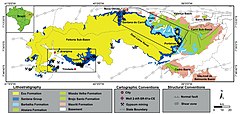Our website is made possible by displaying online advertisements to our visitors.
Please consider supporting us by disabling your ad blocker.
Ipubi Formation
| Ipubi Formation | |
|---|---|
| Stratigraphic range: Aptian-Albian ~ | |
 Outcrop of the Ipubi Formation underlying the Romualdo Formation | |
| Type | Geological formation |
| Unit of | Santana Group |
| Underlies | Romualdo Formation |
| Overlies | Crato Formation |
| Thickness | up to 40 m (130 ft) average 15 m (49 ft) |
| Lithology | |
| Primary | Shale, anhydrite |
| Other | Sandstone |
| Location | |
| Coordinates | 5°36′S 64°18′W / 5.6°S 64.3°W |
| Approximate paleocoordinates | 9°12′S 34°00′W / 9.2°S 34.0°W |
| Region | Pernambuco, Piauí & Ceará |
| Country | |
| Extent | Araripe Basin |
| Type section | |
| Named for | Ipubi |
| Named by | Beurlen |
| Year defined | 1971 |
 The Ipubi Formation is found in the southeastern part of the Araripe Basin, near Ipubi | |
The Ipubi Formation is the middle geological formation of the Santana Group, the middle part of the Araripe Group, in the Araripe Basin of northeastern Brazil. The formation is dated to the Aptian to Albian stages of the Early Cretaceous, unconformably overlying the Crato Formation and unconformably overlain by the Romualdo Formation, formerly known as the Romualdo Member of the Santana Formation. The averaging 15 metres (49 ft) thick Ipubi Formation comprises shales and sandstones in the lower section and evaporites in the upper part of the formation, deposited in a transgressive to highstand lacustrine environment in the Araripe rift basin.
The Ipubi Formation contains little fossils, apart from an indeterminate Pelomedusoides turtle, but contains high levels of TOC and the formation is identified as a potential target for shale gas development.
Previous Page Next Page


